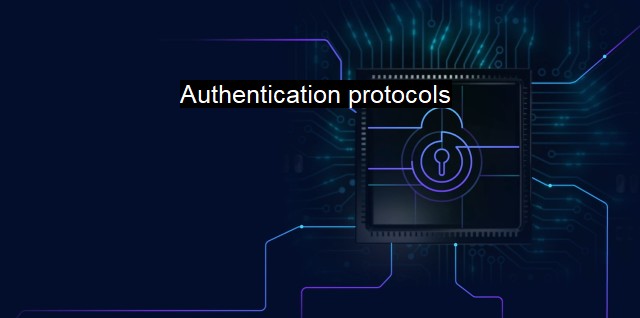What are Authentication protocols?
Ensuring Security Measures: Understanding Authentication Protocols in Cybersecurity and Antivirus
Authentication protocols are foundational processes within cybersecurity that verify the identity of users, systems, and devices before granting access to information or networks. Due to the ever-increasing incidence of network breaches and data thefts, they have gained significant importance in modern cybersecurity protocols as a means to enforce secure boundaries around sensitive data.The primary role of authentication protocols involves ensuring that a user, system, or device is indeed what or who they claim to be before giving them access to protected resources. To do this, the protocols might use various factors like password (what you know), biometrics (who you are), or tokens (what you have). Once the input provided by the user matches with the data stored into system, access is granted.
One common example is the password-based authentication process, where a user provides their unique user name, followed by their password. If these two elements align with those stored on the server, the user can access the system. Another example is biometrics, e.g., fingerprints or iris patterns, frequently used in devices like smartphones for lock-screen authentication.
Multi-factor authentication (MFA) combines two or more independent pieces of evidence, or causes accusation. The intent is to increase protection shield, as an unwarranted user would have to compromise more than one defense line—reducing the chances of a successful attack. a common MFA method involves receiving a code on your mobile device after entering personal credentials.
One of the most widely used types of authentication protocols is the Kerberos protocol used in Windows operating systems. It uses symmetric key cryptography to authenticate client-server applications. Another increasingly popular protocol is OAuth, frequently used by Internet services that offer “Login using Google” or similar options. OAuth uses tokens generated by the server to authenticate users rather than passwords.
In secure file transfer protocols like SSL/TLS and SSH, digital certificates are used. A digital certificate contains the public key of an entity (i.e., a user or a website), digitally signed by a trusted third party - a Certificate Authority (CA). The party that trusts the certificate can then trust that the public key indeed belongs to that entity.
Under the umbrella of antivirus security, authentication protocols assist in authorizing software updates or defining access permissions to certain parts of the system. Antivirus software also uses authentication protocols to validate any data or software being downloaded or accessed by the user to ensure it doesn't contain malicious elements.
Several innovative authentication protocols, like the presence-based ones, utilize a user's mobile device and proximity assumption to provide access. Interestingly, Quantum Key Distribution (QKD) Authentication is promising encryption that can't be cracked even by a quantum computer.
While yielding significant benefits in data safety, authentication protocols have their challenges. Users tend to view authentication prompts as cumbersome, leading to the deployment of poor quality or reused passwords. This, in turn, can weaken the overall purpose of participating in the access control mechanism. the advent of advanced phishing tactics, where hackers create seemingly harmless portals, can trick users into revealing their authentic access details.
Despite these challenges, authentication protocols stay instrumental in securing online spaces. With advancements in technology, such as biometrics and artificial intelligence, they continue to evolve, offering increasingly foolproof and non-invasive methods of verifying identities. Indeed, the implementation of authentication protocols is a journey and not a destination, as they consistently develop with technology and trends. By employing strong authentication protocols, individuals and organizations alike can heighten their resistance to malicious cyber activities and protect their valuable data.

Authentication protocols FAQs
What is an authentication protocol in cybersecurity?
An authentication protocol is a series of steps or procedures that are used to verify the identity of a user or device in a network or system. It is an essential component of cybersecurity that ensures only authorized users have access to sensitive information or resources.What are the different types of authentication protocols?
There are several types of authentication protocols, including password-based authentication, biometric authentication, token-based authentication, certificate-based authentication, and multi-factor authentication. Each protocol has its unique method of verifying the identity of the user or device.Why is authentication protocol important in antivirus software?
Authentication protocols are critical in antivirus software because they help prevent unauthorized access to the antivirus system and its data. Authentication protocols ensure that only authorized users or devices can access the antivirus system, which can prevent attackers from tampering with the antivirus software or disabling it altogether.What are the common issues with authentication protocols?
The most common issues with authentication protocols are weak passwords, poor implementation, and lack of multi-factor authentication. Weak passwords can be easily guessed or cracked by attackers, while poor implementation can lead to vulnerabilities that can be exploited. The absence of multi-factor authentication can also increase the chances of unauthorized access, making it easier for attackers to breach the system.| | A | | | B | | | C | | | D | | | E | | | F | | | G | | | H | | | I | | | J | | | K | | | L | | | M | |
| | N | | | O | | | P | | | Q | | | R | | | S | | | T | | | U | | | V | | | W | | | X | | | Y | | | Z | |
| | 1 | | | 2 | | | 3 | | | 4 | | | 7 | | | 8 | | |||||||